East Preston, Sussex
Up to 1834
In 1728, the parish of Angmering erected a row of six cottages on Arundel Road, for use as 'homes of refuge' for the aged poor — placing them in the category of of what are generally referred to as poorhouses rather than workhouses. Administered by the Overseers of the Poor, the cottages were subsequently let at a rent ranging from sixpences to one shilling and sixpence a week. In 1871, the they were sold on lease to William Jarrett, a local carpenter, for the sum of £185. The properties still exist, now known as Longback Cottages.
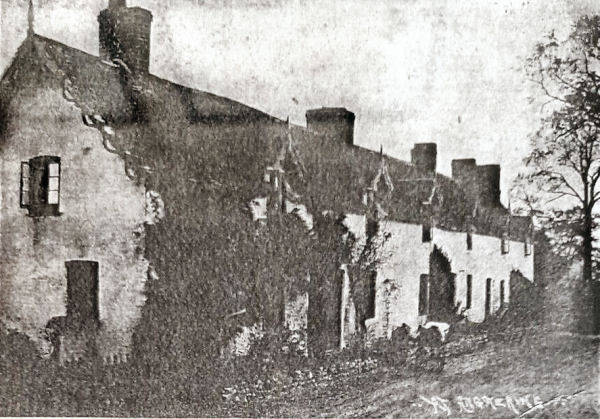
Longback Cottages, Angmering, early 1900s.
A parliamentary report of 1777 recorded parish workhouses in operation at Angmering (for up to 20 inmates), Littlehampton (20), Poleing (12), and Rustington (10).
On 22nd January, 1791, a union was formed under Gilbert's Act by the Sussex parishes of East Preston, Littlehampton, Ferring, Goring by Seas, and Burpham. Lyminster joined in 1793, followed by Amberley, Broadwater, Climping, Ford, Lancing, and Tortington in 1799. In 1803, Durrington, Houghton, West Tarring, and Wiggenholt were added, with Angmering, Poling, Rustington joining in 1806, bringing the total number to 19.
In 1792, a union workhouse was erected in East Preston at a cost of £1,059. The building was enlarged in 1806.
A report in 1834 noted that the union now had twenty members and the average number in the workhouse was no more than 50 in summer and 70 in winter. It also recorded that:
Nine-pence a week is paid for every one short of the number contracted for: this goes to the governor. The house is farmed at 3s. a head per week, wheat being insured to the governor at £10 a load: as wheat rises £1 per load, the contract price rises 1d. per head. A visitor is appointed annually, and attends at the house twice or three times a week. A committee of one from each parish meets at the house the first Monday in every month; and by rotation one of the committee attends at some meal in the course of every week, to give the inmates an opportunity of stating any complaint they may wish to make. The diet is arranged by the committee, and the bread and beer consumed are made in the house. Six meat dinners and one bread and cheese dinner are allowed; also a pint of beer daily. Breakfast consists of milk, bread and cheese, or soup, as it may happen: supper is the same. The inmates are in this house, as in most others in this district, either old and infirm, a few young children, orphans, deserted or bastard, and occasionally females who have been sent home to their parish on account of. pregnancy: 40s. is allowed to the governor for every confinement, from the parish to which the bastard is chargeable. A medical man attends twice a week, at a salary of £15. a year.
There is a manufactory of sacking ropes and bedding, to an extent not exceeding £20 a year. A garden of three-fourtbs of an acre, and a large square yard in the centre of the building, containing another half-acre, belong to the house, which is capable of containing 200 inmates: 103 is the greatest number that have been in it during the last 20 years, for which period the present governor has farmed it. Some of the old people are allowed to smoke, and to some an allowance of tea or tobacco is made. All dine in the same hall, but the sexes take their meals at different tables, and are separated at night: the men sleep two in a bed. No one leaves the house or yard without the permission of the governor. One of the paupers attends at the gate, which was stated to be always locked.
After 1834
Because of its Gilbert Union status, East Preston was largely immune from most of the provisions of the 1834 Poor Law Amendment Act. The workhouse was enlarged in 1853 by the addition of a school-room and an infirmary. The Poor Law Commissioners made repeated efforts to bring about the dissolution of the union and to replace it by a Poor Law Union. However, this did not happen until 1869 when all remaining Gilbert Unions were finally abolished, including the nearby Sutton Incorporation. In the subsequent reorganisation of poor law administrative boundaries in the area, a new East Preston Poor Law Union was formally declared on 29th September 1869. It was administered by an elected Board of Guardians, 27 in number, representing its 23 constituent parishes as listed below (figures in brackets indicate numbers of Guardians if more than one):
Sussex:
Angmering, Arundel (2), Broadwater (3), Burpham, Clapham, Climping, Durrington, East Preston, Ferring, Ford, Goring, Heene, Houghton, Kingston, Leominster (2), Littlehampton, Patching, Poling, Rustington, South Stoke, Tortington, Warningcamp, West Tarring.
Later Additions: Wick (1901), Worthing (1894).
A new workhouse, with a T-shaped layout designed by GB Nichols, was built on the same site in 1872-3.
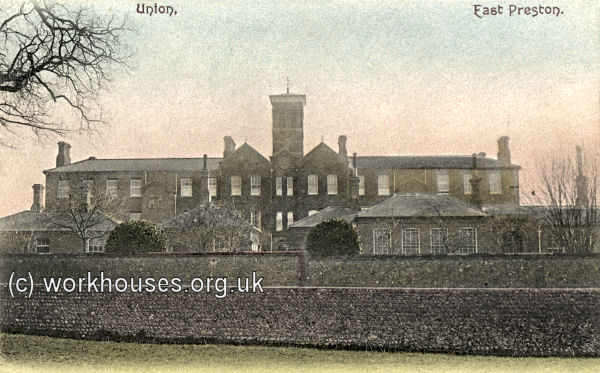
East Preston workhouse from the north, early 1900s.
The site location and layout can be seen on the 1910 map below.
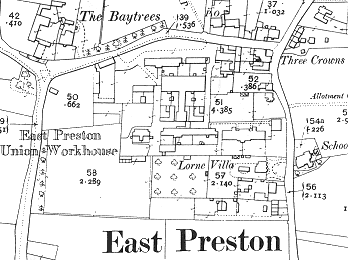
East Preston workhouse site, 1910.
An infirmary and nurses' home were added at the south-east in 1906.
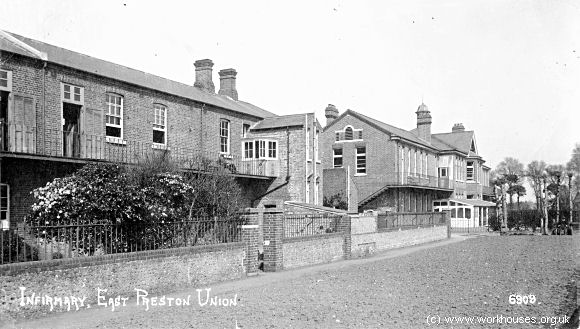
East Preston workhouse infirmary from the south-west, c.1910.
© Peter Higginbotham.
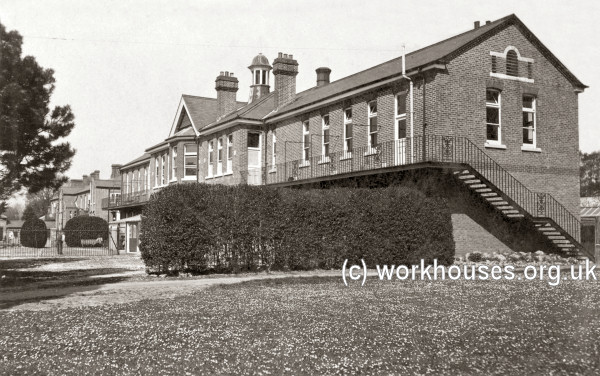
East Preston workhouse infirmary from the south-east, c.1910.
© Peter Higginbotham.
From 1904, to protect them from disadvantage in later life, the birth certificates for those born in the workhouse gave its address just as North View, East Preston.
In 1930, the workhouse site was taken over by Sussex County Council and subsequently the North View home. The building was demolished in 1969 and the site sold off for redevelopment. Soon afterwards, the Fairlands housing estate was erected.
Staff
Inmates
Records
Note: many repositories impose a closure period of up to 100 years for records identifying individuals. Before travelling a long distance, always check that the records you want to consult will be available.
- West Sussex Record Office, County Hall, Chichester, West Sussex PO19 1RN. Holdings include: Guardians' minutes (1869-1930); Births (1792-1834, 1869-1951); Deaths (1870-1934); Relief lists (1820-48); etc.
Bibliography
- Higginbotham, Peter Workhouses of London and the South East (2019)
- Standing, R.W. (2000) East Preston Gilbert Union Workhouse 1791-1869
Links
- None.
Unless otherwise indicated, this page () is copyright Peter Higginbotham. Contents may not be reproduced without permission.


